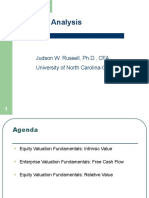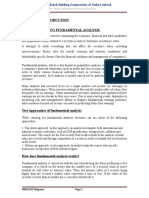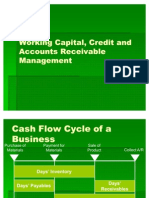Fundamental Stock Analysis: Chapter Seven
Fundamental Stock Analysis: Chapter Seven
Uploaded by
Assfaw KebedeCopyright:
Available Formats
Fundamental Stock Analysis: Chapter Seven
Fundamental Stock Analysis: Chapter Seven
Uploaded by
Assfaw KebedeOriginal Title
Copyright
Available Formats
Share this document
Did you find this document useful?
Is this content inappropriate?
Copyright:
Available Formats
Fundamental Stock Analysis: Chapter Seven
Fundamental Stock Analysis: Chapter Seven
Uploaded by
Assfaw KebedeCopyright:
Available Formats
CHAPTER SEVEN
FUNDAMENTAL STOCK ANALYSIS
1
2001 South-Western College Publishing
2
Outline
Valuation Philosophies
Investors Understanding of Risk Premiums
The Time Value of Money
The Importance of Cash Flows
The Tax Factor
EIC Analysis
Value vs. Growth Investing
The Value Approach to Investing
The Growth Approach to Investing
How Price Relates to Value
Value Stocks and Growth Stocks:
How to Tell by Looking
3
Outline
Some Analytical Factors
Growth Rates
The Dividend Discount Model
The Multistage DDM
Caveats about the DDM
False Growth
A Firms Cash Flows
Small-Cap, Mid-Cap, and Large-Cap Stocks
Ratio Analysis
Cooking the Books
4
Valuation Philosophies
Fundamental analysts believe
securities are priced according to
fundamental economic data.
Technical analysts think investor behavior
and supply and demand factors play the
most important role.
5
Valuation Philosophies
Investors understanding of risk premiums:
Investors are almost always risk-averse.
The time value of money:
Everyone agrees on this basic principle.
The importance of cash flows:
Most investment research deals with
predicting future corporate earnings.
The tax factor:
The tax code is complicated and not all
investments are taxed equally.
6
Valuation Philosophies
Economy, Industry, and Company (EIC)
analysis:
The analyst first considers conditions in
the overall economy (market risk),
then determines which industries are the
most attractive in light of the economic
conditions (using Porters competitive
strategy analysis framework, for example),
and finally identifies the most attractive
companies within the attractive
industries.
7
Value vs. Growth Investing
A value investor believes that securities
should be purchased only when the
underlying fundamentals (macroeconomic
information, industry news, and a firms
financial statements) justify the purchase.
Value investors believe in a regression
to the mean.
The Value Approach to Investing
8
Regression to the Mean
Most of the time
a securitys long-
term return is
consistent with its
risk.
Over the long run, a security
cannot survive with a cumulative
return that is negative.
C
u
m
u
l
a
t
i
v
e
R
e
t
u
r
n
Time in the Long Term
0
+
-
x
x
x
x
x
x
x
x
x
x
x
x
x
x
x
Undervalued stock: Buy
Overvalued stock: Sell
9
Value vs. Growth Investing
Growth investors seek steadily growing
companies. There are two factions:
Information traders are in a hurry; they
believe information differentials in the
marketplace can be profitably exploited.
True growth investors are more willing to
wait, but they share the belief that good
investment managers can earn above-
average returns for their clients.
The Growth Approach to Investing
10
Value vs. Growth Investing
In the early days of the market, before the
Great Crash of 1929, price played a minor
role: A stock with good long-term
prospects is always a good investment.
How Price Relates to Value
The modern perspective is that
value is inextricably intertwined
with price.
11
Value vs. Growth Investing
No precise definition exists.
Classification by Morningstar Mutual Funds:
Value Stocks and Growth Stocks:
How to Tell by Looking
>
<
blend - otherwise
growth - 2.25
value - 1.75 relative
price to book
ratio
relative
price-earnings
ratio
+
12
Value vs. Growth Investing
The price to book ratio: book value per
share is an accounting concept
synonymous with equity per share.
The price-earnings ratio (PE) is computed
by dividing the current stock price by the
firms earnings per share.
Because of differences among industries,
relative ratios are commonly computed for
both statistics.
Some Analytical Factors: Growth Rates
Growth rates from historical data:
periods g compoundin of number where
value beginning
value ending
rate growth
mean geometric
=
|
|
.
|
\
|
=
n
n
1
1
( )
averages arithmetic using
equity on return ratio payout - 1 rate growth =
Growth rates from earnings retention:
13
14
Some Analytical Factors: Growth Rates
Financial analysts typically calculate a
number of growth rates using different
ways to determine a likely range for the
statistic.
Recent data may be more reliable than data
from the more distant past.
Company statements regarding company
targets may be considered too.
Choosing a Growth Rate
15
Some Analytical Factors: Growth Rates
Another important source of growth rate
estimates is from other security analysts.
Two popular services that monitor and
report these estimates are Zacks and the
Institutional Brokerage Estimate Service
(I/B/E/S).
Growth Rate Estimates from Other Analysts
16
The Dividend Discount Model (DDM)
Also called Gordons growth model.
The model assumes that the dividend
stream is perpetual and that the long-
term growth rate is constant.
( )
stock the of riskiness the
to according factor discount the is
rate growth dividend expected the is
next year paid be to dividend the is
dividend current the is where
price current
k
g
D
D
g k
D
g k
g D
P
1
0
1 0
0
1
+
=
17
The Dividend Discount Model (DDM)
The variable k is sometimes called the
shareholders required rate of return.
Note that the shareholders required rate of
return is the sum of the expected dividend
yield and the expected stock price
appreciation.
( )
g
P
g D
k +
+
=
0
0
1
18
The Multistage DDM
Often, initial high growth levels cannot be
sustained.
Suppose the growth rate g is expected to
persist from the third year:
( )
( )
( ) ( )
( )
2
2
2
2 1
0
1
1
1
1
k
g k g D
k
D
k
D
P
+
+
+
+
+
+
=
19
Some Analytical Factors
Caveats about the DDM:
The DDM is at most a useful tool in
security analysis - it requires certain
assumptions and it has shortcomings.
False growth:
False growth occurs when a firm acquires
another firm with a lower price-earnings
ratio - historical data should always be
scrutinized carefully when used to
determine a growth rate.
20
Some Analytical Factors
A firms cash flow:
The statement of cash flows is a useful
analytical tool - the cash flow from
operations figures are widely used as a
check on a firms earnings quality.
Small-cap, mid-cap, and large-cap stocks:
Another consideration in fundamental
stock analysis relates to the size of the
firm - for example, the small firm effect.
21
Some Analytical Factors: Ratio Analysis
The fundamental analyst is necessarily
interested in the firms accounting
statements and in the prevailing general
economic conditions.
To assist in the analysis, several
organizations publish comparative
statistics for industry groups.
e.g. Dun and Bradstreets Industry Norms
& Key Business Ratios, which
includes solvency, efficiency and
profitability ratios.
22
Some Analytical Factors: Cooking the Books
All publicly traded firms in the United States
must have their financial statements
audited to ensure they fairly present the
companys financial position.
Still, every year there is at least one story of
accounting fraud at a major firm.
Unfortunately, there is not much the analyst
can do about fraud.
23
Review
Valuation Philosophies
Investors Understanding of Risk Premiums
The Time Value of Money
The Importance of Cash Flows
The Tax Factor
EIC Analysis
Value vs. Growth Investing
The Value Approach to Investing
The Growth Approach to Investing
How Price Relates to Value
Value Stocks and Growth Stocks:
How to Tell by Looking
24
Review
Some Analytical Factors
Growth Rates
The Dividend Discount Model
The Multistage DDM
Caveats about the DDM
False Growth
A Firms Cash Flows
Small-Cap, Mid-Cap, and Large-Cap Stocks
Ratio Analysis
Cooking the Books
You might also like
- Hostess Training TopicsDocument30 pagesHostess Training Topicsjuliusjim100% (4)
- Research Methodology of Portfolio ManagementDocument6 pagesResearch Methodology of Portfolio ManagementZalak Shah100% (1)
- Valuation Analysis: Judson W. Russell, PH.D., CFA University of North Carolina-CharlotteDocument86 pagesValuation Analysis: Judson W. Russell, PH.D., CFA University of North Carolina-CharlottepafitNo ratings yet
- Credit Suisse - Measuring The MoatDocument70 pagesCredit Suisse - Measuring The MoatJames Kuah100% (1)
- Characteristics of Developing CountriesDocument32 pagesCharacteristics of Developing CountriesAssfaw Kebede100% (5)
- WACC and Vol: Counterpoint Global InsightsDocument13 pagesWACC and Vol: Counterpoint Global InsightsHoward QinNo ratings yet
- Maps of World Finance Your Window To The WorldDocument5 pagesMaps of World Finance Your Window To The WorldJitesh PandyaNo ratings yet
- Valuation of IM Firms Presentation 3-26-13Document34 pagesValuation of IM Firms Presentation 3-26-13Elie YabroudiNo ratings yet
- Investment Analysis 9Document17 pagesInvestment Analysis 9KhanozaiNo ratings yet
- Fundamental Analysis of ICICI BankDocument79 pagesFundamental Analysis of ICICI BanksantumandalNo ratings yet
- Security Analysis Bba-Iv (Elective Finance)Document21 pagesSecurity Analysis Bba-Iv (Elective Finance)Bahawal Khan JamaliNo ratings yet
- Measuring The Moat PDFDocument70 pagesMeasuring The Moat PDFFlorent CrivelloNo ratings yet
- Analyzing Common Stocks PPT at BEC DOMSDocument47 pagesAnalyzing Common Stocks PPT at BEC DOMSBabasab Patil (Karrisatte)No ratings yet
- Gordon Growth Model Dividend Payout RatioDocument3 pagesGordon Growth Model Dividend Payout RatioCoryNo ratings yet
- Chapter 4 - The Investing DecisionsDocument20 pagesChapter 4 - The Investing DecisionsMotiram paudelNo ratings yet
- Stock ValuationDocument7 pagesStock ValuationBrenner BolasocNo ratings yet
- Fundamental AnalysisDocument5 pagesFundamental AnalysisHeena SinglaNo ratings yet
- Valuation AnalysisDocument86 pagesValuation Analysisollllllllllo100% (1)
- Research Paper On Credit RatingDocument8 pagesResearch Paper On Credit Ratingafeenylsy100% (1)
- Dividend Discount ModelDocument17 pagesDividend Discount ModelNirmal ShresthaNo ratings yet
- Fundamentals of Banking A Project ReportDocument45 pagesFundamentals of Banking A Project Reportaftabshaikh04No ratings yet
- Research Paper On Company ValuationDocument8 pagesResearch Paper On Company Valuationfys374dr100% (1)
- Investment Strategies Using Fundamental Analysis - CompaniesDocument15 pagesInvestment Strategies Using Fundamental Analysis - CompaniesdkldkdkdNo ratings yet
- Equity Research-Measuring The MoatDocument117 pagesEquity Research-Measuring The MoatproxygangNo ratings yet
- American Greeting Case StudyDocument8 pagesAmerican Greeting Case Studyhchen0023No ratings yet
- Inv - CH-5Document28 pagesInv - CH-5mickamhaaNo ratings yet
- SAPM - Security AnalysisDocument7 pagesSAPM - Security AnalysisTyson Texeira100% (1)
- READING 7 Dividend Discount Model (Equity Valuation)Document28 pagesREADING 7 Dividend Discount Model (Equity Valuation)DandyNo ratings yet
- Fundamentals of Stock AnalysisDocument39 pagesFundamentals of Stock Analysisraveendhar.k100% (5)
- Pay Down Debt: What Are The Benefits of Issuing Common StockDocument6 pagesPay Down Debt: What Are The Benefits of Issuing Common StockawaljanNo ratings yet
- Subject: Corporate Financial Accounting: Nes Ratnam College of Arts, Science and CommerceDocument64 pagesSubject: Corporate Financial Accounting: Nes Ratnam College of Arts, Science and Commercejaya ranguNo ratings yet
- CH 18Document40 pagesCH 18Louina YnciertoNo ratings yet
- FM414 LN 5 Master Copy Presentation Solutions - Discount Rates - 2024 ColorDocument19 pagesFM414 LN 5 Master Copy Presentation Solutions - Discount Rates - 2024 ColorAntonio AguiarNo ratings yet
- Fundamental of ValuationDocument39 pagesFundamental of Valuationkristeen1211No ratings yet
- Business Valuation DissertationDocument7 pagesBusiness Valuation DissertationPaySomeoneToWriteYourPaperHighPoint100% (1)
- Research Proposal For Portfolio Management in Banking, IT and Pharmaceutical SectorDocument6 pagesResearch Proposal For Portfolio Management in Banking, IT and Pharmaceutical Sectorzalaks67% (3)
- Security Analysis: Learning Objective Fundamental AnalysisDocument0 pagesSecurity Analysis: Learning Objective Fundamental AnalysisGunjan Resurrected RanjanNo ratings yet
- Two Categories of Valuation ModelsDocument5 pagesTwo Categories of Valuation Modelslapofaw861No ratings yet
- Chapter 6 Security AnalysisDocument46 pagesChapter 6 Security AnalysisAshraf KhamisaNo ratings yet
- Equity Securities MarketDocument40 pagesEquity Securities MarketBea Bianca MadlaNo ratings yet
- Estimating Hurdle Rates I: Defining & Measuring RiskDocument12 pagesEstimating Hurdle Rates I: Defining & Measuring RiskAnshik BansalNo ratings yet
- ECON75 Lecture VI. Valuation Financial AnalysisDocument120 pagesECON75 Lecture VI. Valuation Financial AnalysisJoshua De VeraNo ratings yet
- Fundamental Analysis Principles, Types, and How To Use It $$$$$Document8 pagesFundamental Analysis Principles, Types, and How To Use It $$$$$ACC200 MNo ratings yet
- Q1 Explain What Is CAMELS Framework Used in Banking AnalysisDocument2 pagesQ1 Explain What Is CAMELS Framework Used in Banking Analysisshubham ghodkeNo ratings yet
- Session-13 - Prospective Analysis-FSA (Compatibility Mode)Document37 pagesSession-13 - Prospective Analysis-FSA (Compatibility Mode)pgp39081No ratings yet
- Software AnalysisDocument7 pagesSoftware AnalysisPrudhviRajNo ratings yet
- Fundamental and Technical AnalysisDocument17 pagesFundamental and Technical AnalysisdhanendrapardhiNo ratings yet
- C11 An Introduction To Security ValuationDocument37 pagesC11 An Introduction To Security Valuationharisali55No ratings yet
- Equity AnalysisDocument6 pagesEquity AnalysisVarsha Sukhramani100% (1)
- Analysing Common Stocks - FUNDAMENTAL ANALYSISDocument47 pagesAnalysing Common Stocks - FUNDAMENTAL ANALYSISAarthi SutharNo ratings yet
- Securities Analysis & Portfolio ManagementDocument52 pagesSecurities Analysis & Portfolio ManagementruchisinghnovNo ratings yet
- 02.damodaran - Corporate FinanceDocument239 pages02.damodaran - Corporate Financessj9100% (1)
- MRF Tyres LTD OverviewDocument9 pagesMRF Tyres LTD OverviewVivek Mohan KumarNo ratings yet
- Company Analysis of Madras Rubber Factory (MRF) LimitedDocument9 pagesCompany Analysis of Madras Rubber Factory (MRF) LimitedRashmi PrasadNo ratings yet
- Planning Reporting: Financial AnalysisDocument5 pagesPlanning Reporting: Financial Analysisriz2010No ratings yet
- Valuation of SharesDocument51 pagesValuation of SharesSwati GoyalNo ratings yet
- Valuation - DCFDocument38 pagesValuation - DCFKumar Prashant100% (1)
- Valuation Matters The Complete Guide to Company Valuation TechniquesFrom EverandValuation Matters The Complete Guide to Company Valuation TechniquesNo ratings yet
- Summary of Michael J. Mauboussin & Alfred Rappaport's Expectations InvestingFrom EverandSummary of Michael J. Mauboussin & Alfred Rappaport's Expectations InvestingNo ratings yet
- Investment Analysis and Portfolio Management: Frank K. Reilly & Keith C. BrownDocument38 pagesInvestment Analysis and Portfolio Management: Frank K. Reilly & Keith C. BrownAssfaw KebedeNo ratings yet
- Investment Analysis and Portfolio Management: Lecture Presentation SoftwareDocument35 pagesInvestment Analysis and Portfolio Management: Lecture Presentation SoftwareAssfaw KebedeNo ratings yet
- Investing For GrowthDocument8 pagesInvesting For GrowthAssfaw KebedeNo ratings yet
- Eco4504 TestDocument7 pagesEco4504 TestAssfaw Kebede0% (1)
- Public Finance Lecture NotesDocument26 pagesPublic Finance Lecture NotesAssfaw KebedeNo ratings yet
- Gruber3e Ch05Document34 pagesGruber3e Ch05Assfaw KebedeNo ratings yet
- Keynesian Multiplier EffectsDocument45 pagesKeynesian Multiplier EffectsRajat SharmaNo ratings yet
- As Public Merit Demerit GoodsDocument7 pagesAs Public Merit Demerit GoodsAssfaw KebedeNo ratings yet
- CH09Document98 pagesCH09Assfaw KebedeNo ratings yet
- Public Finance Lecture NotesDocument26 pagesPublic Finance Lecture NotesAssfaw KebedeNo ratings yet
- Investment Analysis and Portfolio Management: Lecture Presentation SoftwareDocument57 pagesInvestment Analysis and Portfolio Management: Lecture Presentation SoftwareAssfaw KebedeNo ratings yet
- Yumna - 1665042300Document3 pagesYumna - 1665042300YumnaNo ratings yet
- SOAL Jawab PG B.ING II JULI 2019 SET 1 & 2Document7 pagesSOAL Jawab PG B.ING II JULI 2019 SET 1 & 2rezaliniNo ratings yet
- Euw Conference BrochureDocument12 pagesEuw Conference Brochurenacera_friziNo ratings yet
- Assignment 2 - AirAsiaDocument8 pagesAssignment 2 - AirAsiaRevathi PattuNo ratings yet
- Diguskq JbkjbaDocument13 pagesDiguskq JbkjbaAdityaNo ratings yet
- AMC IPR Slides FinalDocument32 pagesAMC IPR Slides FinalBront PalaraeNo ratings yet
- PG 44 A Sample of Sampling Methods AnswersDocument1 pagePG 44 A Sample of Sampling Methods AnswersEdal Santos100% (1)
- Working Capital, Credit and Accounts Receivable ManagementDocument31 pagesWorking Capital, Credit and Accounts Receivable ManagementAnkit Agarwal100% (1)
- Product Portfolio ManagementDocument4 pagesProduct Portfolio ManagementAna Maria Spasovska100% (1)
- For LudhianaDocument2 pagesFor Ludhianayaman raoNo ratings yet
- Secret To Approaching Prospects: - by Randy GageDocument4 pagesSecret To Approaching Prospects: - by Randy GageA.G. BhatNo ratings yet
- Guide To Companies in Mauritius (February 2014)Document50 pagesGuide To Companies in Mauritius (February 2014)vdbossNo ratings yet
- A Summer Training Project Report On Tata Aig 2010-11 MuzaffarnagarDocument105 pagesA Summer Training Project Report On Tata Aig 2010-11 Muzaffarnagarghanshyam1988No ratings yet
- Inventory CycleDocument38 pagesInventory CycleSarah Laras WitaNo ratings yet
- The Characteristics of Entrepreneurs Are Briefly Discussed BelowDocument3 pagesThe Characteristics of Entrepreneurs Are Briefly Discussed Belowshahryar khanNo ratings yet
- Week 2 Practice 111Document16 pagesWeek 2 Practice 111Angel BtNo ratings yet
- CcarDocument2 pagesCcarRohini SinghNo ratings yet
- Nature and Environment of AccountingDocument21 pagesNature and Environment of AccountingJeon JeonNo ratings yet
- FMN PLC Annual Report 2017-MinDocument149 pagesFMN PLC Annual Report 2017-MinKayode AdelekeNo ratings yet
- Cybersecurity Is Everyones JobDocument28 pagesCybersecurity Is Everyones JobAndrew Richard Thompson100% (5)
- Chapter-I: 1.1. Indian Two-Wheeler SectorDocument32 pagesChapter-I: 1.1. Indian Two-Wheeler SectorPrithvi BarodiaNo ratings yet
- 1540025975585V2Aln72X00W6W7Sg PDFDocument3 pages1540025975585V2Aln72X00W6W7Sg PDFMehul GajjarNo ratings yet
- DOCC Project at AERFDocument45 pagesDOCC Project at AERFcutenikNo ratings yet
- Monitor and Review Budget Case SolutionsDocument2 pagesMonitor and Review Budget Case Solutionscharith sai t 122013601002No ratings yet
- Administrating GoldMine PDFDocument447 pagesAdministrating GoldMine PDFRubén Rubio BarreraNo ratings yet
- JanuaryDocument4 pagesJanuaryalihassan459001No ratings yet
- Kajaria CSRDocument5 pagesKajaria CSRASHISH BHATNo ratings yet
- CFA India Society - US - 3 SepDocument22 pagesCFA India Society - US - 3 SepTina PhilipNo ratings yet
- Remedies - Equity and Equitable RemediesDocument55 pagesRemedies - Equity and Equitable RemediesGeorge ConkNo ratings yet




































































































